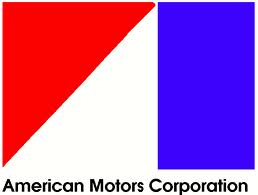A brief history of
AMC
Introduction
The car manufacturer AMC has made an important impact on the automotive world. In this article we will give a brief but detailed history of the AMC marque.
We will look at the origins of AMC looking at who, why, where and when AMC was founded. We'll look at the design of the iconic AMC logo and what are some the more significant AMC models.
We'll take a glance at what racing history the AMC has and who some of the most important people have been in the history of AMC over the years.
Who, where, when and why was
AMC founded?
AMC, short for American Motors Corporation, was founded in 1954 as a merger between two struggling American automobile manufacturers, Nash-Kelvinator Corporation and Hudson Motor Car Company. The formation of AMC took place in Detroit, Michigan, the heart of the American automotive industry at the time. The merger was a strategic move to consolidate resources, reduce costs, and create a stronger competitor in the highly competitive automotive market.
The decision to merge Nash-Kelvinator and Hudson was driven by several factors. Both companies were facing financial difficulties due to increased competition from the Big Three automakers (General Motors, Ford, and Chrysler) and the rising costs of research and development. By joining forces, Nash-Kelvinator and Hudson hoped to leverage their combined strengths and improve their chances of survival in an increasingly challenging industry.
Furthermore, the merger aimed to create a company that could offer a wider range of vehicles to consumers. Nash-Kelvinator was known for its compact and fuel-efficient cars, while Hudson had a reputation for larger, more powerful vehicles. By combining their product portfolios, the new company could cater to a broader customer base and address different segments of the market.
The merger officially took place on May 1, 1954, with the formation of American Motors Corporation. The headquarters of the new company were established in Southfield, Michigan. George W. Mason, the former president of Nash-Kelvinator, was appointed as the first president of AMC.
The creation of AMC was driven by the desire to achieve economies of scale, share resources, and create a stronger competitor in the automotive industry. The company faced significant challenges in its early years, but it managed to survive and make a mark with its innovative and unconventional approach to car design and marketing.
Over the years, AMC produced a range of notable vehicles, including the compact Rambler models, the iconic Jeep lineup, and the high-performance AMX and Javelin muscle cars. Despite its eventual acquisition by Chrysler Corporation in 1987, AMC left a lasting impact on the automotive industry and remains an important part of American automotive history.
How did the
AMC logo originate?

How did the AMC logo originate?
The history of the AMC logo traces back to the company's formation in 1954. As a newly merged entity, American Motors Corporation needed a logo that represented its identity and communicated its values to the public.
The original AMC logo featured a shield design with a stylized "A" in the center. The "A" was formed by two overlapping triangles, creating a dynamic and modern look. This logo symbolized the unity of the merged companies and the forward-thinking approach of the newly formed corporation. The shield shape conveyed strength and protection, while the use of triangles added a sense of innovation and progress.
As the years went by, the AMC logo underwent several revisions to reflect the evolving identity of the company. In the late 1960s, AMC introduced a new logo that featured a simplified version of the original shield design. The "A" was retained, but the triangles were removed, resulting in a cleaner and more streamlined look.
In the 1970s, AMC introduced another logo iteration that incorporated a circular design. The circular emblem featured the letters "AMC" in bold typography, surrounded by a ring. This logo aimed to create a more recognizable and memorable brand image for the company.
With the acquisition of AMC by Chrysler Corporation in 1987, the AMC logo was phased out, and the vehicles began to carry the Chrysler logo instead. However, the legacy of AMC lives on in the hearts of automotive enthusiasts and collectors, who still appreciate the unique and innovative vehicles produced by the company.
What are some of the significant
AMC models?
AMC, known for its innovative and bold approach to car manufacturing, produced several significant models throughout its history. These vehicles showcased AMC's commitment to performance, style, and affordability, making them popular choices among car enthusiasts. Let's explore some of AMC's most notable models, focusing on the higher performance ones, from each quarter of its history.
In the 1960s, AMC introduced the iconic Rambler Rebel. This mid-size car was available in different configurations, including a high-performance variant known as the Rebel "Machine." With its powerful V8 engine, performance upgrades, and distinctive white and red color scheme, the Rebel Machine captured the spirit of the muscle car era. It was a formidable competitor on the drag strips and cemented AMC's reputation for producing powerful and visually striking vehicles.
Moving into the 1970s, AMC launched the Javelin AMX. This compact, two-door coupe was designed for speed and agility. It featured a range of engine options, including the potent 390 and 401 cubic-inch V8s. With its aggressive styling, wide stance, and improved suspension, the Javelin AMX delivered an exhilarating driving experience. It was a popular choice among performance enthusiasts and even saw success on the racing circuit, earning AMC multiple victories in the Trans-Am racing series.
As the 1980s rolled in, AMC introduced the Spirit AMX. This compact car packed a punch with its high-output 4.2-liter inline-six engine or an optional V8. The Spirit AMX boasted a lightweight body and nimble handling, making it a fun and affordable option for performance-minded drivers. Despite its compact size, it offered impressive acceleration and cornering capabilities.
Finally, in the 1990s, AMC unveiled the Eagle Talon TSi. This sporty coupe was a collaboration between AMC and Mitsubishi, featuring advanced technologies and turbocharged power. With its all-wheel drive system and a range of turbocharged engine options, including a potent 2.0-liter inline-four, the Eagle Talon TSi delivered impressive performance and handling. It became a favorite among the import tuner community and found success in various motorsport events, such as drag racing and rallying.
Throughout its history, AMC demonstrated its commitment to producing high-performance vehicles that pushed the boundaries of innovation. From the muscle car era to the compact sports cars of the 1980s and 1990s, AMC models left a lasting impact on the automotive industry, showcasing the brand's passion for performance and driving excitement.

One of AMC's Most Iconic Models
Who are some of the most important people in
AMC's History
Behind the success of AMC were several significant individuals who played key roles in shaping the company's direction, innovation, and overall impact on the automotive industry.
One notable person is Roy Abernethy, who served as the President of AMC from 1962 to 1967. Abernethy was a charismatic leader known for his marketing acumen. Under his guidance, AMC experienced substantial growth and success. He focused on positioning AMC as an alternative to the "Big Three" automakers by emphasizing fuel efficiency, affordability, and innovative designs. Abernethy's leadership helped solidify AMC's position in the market and attract a loyal customer base.
Another influential figure in AMC's history is Richard A. Teague, the company's chief stylist. Teague's creative vision and design expertise resulted in the development of several iconic AMC models. He was responsible for the striking design of the Javelin, AMX, and the forward-thinking AMC Pacer. Teague's designs were often characterized by bold lines, unique features, and a distinctive aesthetic that set AMC vehicles apart from their competitors.
In addition to Abernethy and Teague, the engineering prowess of AMC was shaped by men like Francois Castaing. Castaing was a talented engineer and executive who joined AMC in the 1970s. He played a significant role in the development of the AMC Eagle, the company's innovative all-wheel drive vehicle. Castaing's expertise in engineering and his ability to innovate helped AMC deliver unique and capable vehicles that stood out in the market.
Lastly, George W. Romney, who served as AMC's President and CEO from 1954 to 1962, played a crucial role in the company's early years. Romney was a dynamic leader known for his hands-on approach and strategic thinking. He implemented several changes within the company, including focusing on compact cars, fuel efficiency, and cost-effective manufacturing methods. Romney's emphasis on these areas helped AMC gain a competitive edge in the market.
These individuals, among many others, contributed their skills, vision, and leadership to AMC's success. Their collective efforts helped the company navigate through challenging times, introduce innovative models, and establish a unique identity in the automotive landscape.

One of the most influential people in the history of AMC
AMC's Racing History
AMC, while primarily known for its production vehicles, also had a notable presence in the racing world. The company's involvement in motorsports was a testament to its commitment to performance and competition.
One of the most significant chapters in AMC's racing history began in the late 1960s with the introduction of the AMC Javelin, a car specifically designed to compete in the Trans-Am series. The Javelin proved to be a formidable contender, showcasing AMC's dedication to high-performance racing. In 1971, racing legend Mark Donohue joined the AMC team and piloted the Javelin to great success, winning the Trans-Am Championship that year. Donohue's achievements not only brought attention to AMC's racing endeavors but also solidified the Javelin's reputation as a competitive and capable race car.
AMC's involvement in motorsports extended beyond the Trans-Am series. In the early 1970s, the company ventured into the world of drag racing. AMC developed the "Rebel Machine," a high-performance variant of the AMC Rebel, specifically designed for drag strip competitions. The Rebel Machine featured a powerful V8 engine, upgraded suspension, and distinctive styling. AMC actively promoted the Rebel Machine in the NHRA drag racing circuit, where it competed in various classes. While not as dominant as some of its competitors, the Rebel Machine showcased AMC's commitment to performance and served as a platform to demonstrate the capabilities of its vehicles.
In addition to the Javelin and Rebel Machine, AMC also participated in other racing events and disciplines. The company fielded entries in endurance racing, such as the 24 Hours of Daytona, as well as rallying events. AMC vehicles, including the Hornet and the Spirit, competed in rallies like the Safari Rally in Africa and the Southern Cross Rally in Australia. While not always achieving podium finishes, AMC's participation in these events helped to promote its vehicles and demonstrate their durability and performance.
Despite AMC's relatively limited resources compared to some of the larger automakers, the company's racing endeavors left a lasting impact on the motorsports scene. Through their participation in various racing series and events, AMC showcased their engineering capabilities and proved that they could compete with larger and more established manufacturers.
Overall, AMC's racing history exemplifies the company's determination to be more than just a manufacturer of practical and affordable cars. It highlights their willingness to take on the challenges of motorsports, push the boundaries of performance, and demonstrate their prowess on the track.
Summary
AMC, the American Motors Corporation, was a pioneering automobile manufacturer that operated from 1954 to 1988. Formed through the merger of Hudson Motor Car Company and Nash-Kelvinator Corporation, AMC aimed to produce compact and affordable vehicles without compromising on style and performance. The company introduced several noteworthy models, including the iconic AMC Gremlin and the rugged Jeep CJ. Despite facing challenges, such as financial difficulties, AMC's ability to adapt and innovate left a lasting impact on the automotive industry.
AMC's lineup featured a range of vehicles that catered to different segments of the market. The AMC Gremlin, with its distinctive design and compact size, became synonymous with the 1970s automotive scene. On the other hand, the Jeep CJ gained popularity as a versatile off-road vehicle, showcasing AMC's capabilities in the utility segment. Additionally, AMC ventured into the luxury market with the AMC Matador, a stylish sedan that demonstrated the company's versatility and ambition.
View AMC Car Specifications
More Manufacturer Histories.

























